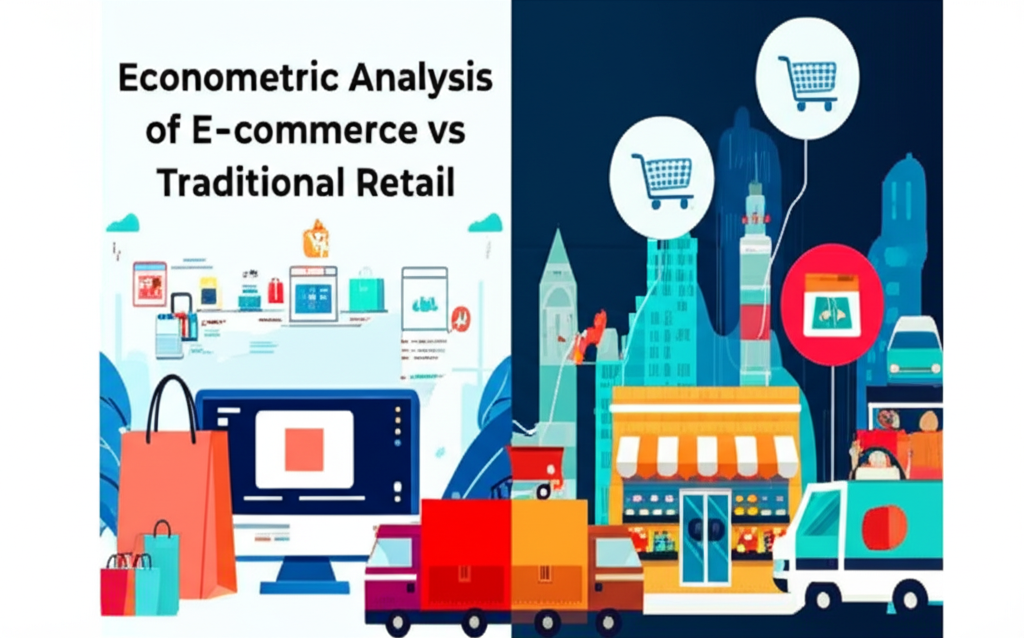
The rapid rise of e-commerce growth over the past two decades has fundamentally transformed the retail landscape worldwide. As consumers increasingly favor online shopping, traditional brick-and-mortar stores face significant challenges, with many experiencing declines in foot traffic and sales. This article uses econometric methods to evaluate the impact of e-commerce growth on traditional retail, revealing critical insights into changing consumer behavior, market structure shifts, and evolving retail trends.
Contents
- 1 Understanding the Shift: E-commerce Growth and Traditional Retail Decline
- 2 Modeling Consumer Behavior Changes with Econometrics
- 3 Examining Retail Market Structure Shifts
- 4 Forecasting Future Retail Trends Using Econometric Methods
- 5 Policy Implications and Recommendations
- 6 Case Study: Econometric Analysis in Action
- 7 Challenges and Limitations
- 8 Conclusion
Understanding the Shift: E-commerce Growth and Traditional Retail Decline
The expansion of e-commerce has introduced a paradigm shift in how consumers access products and services. Econometric analysis, especially panel data and time series models, offers a powerful tool to quantify the relationship between e-commerce growth and the decline of traditional retail.
Studies applying difference-in-differences techniques compare regions with varying levels of internet penetration to isolate the causal impact of online shopping. Findings consistently show that areas with rapid e-commerce adoption experience significant reductions in physical store sales, particularly in apparel, electronics, and consumer goods sectors.
Modeling Consumer Behavior Changes with Econometrics
Changes in online consumer behavior are crucial drivers behind retail market transformations. Econometric models such as logistic regression and multinomial choice models help analyze consumer preferences and switching patterns from offline to online channels.
For instance, data from consumer surveys and transaction records can be used to estimate the probability that a consumer will shift their shopping to an e-commerce platform based on factors like convenience, pricing, and delivery speed. These models highlight how demographic variables, such as age and income, moderate the speed and extent of adoption.
Examining Retail Market Structure Shifts
Beyond individual behavior, market structure shifts occur as new e-commerce entrants disrupt traditional retail chains. Using structural econometric modeling, researchers can estimate the changing market shares, entry and exit patterns, and competitive dynamics within retail sectors.
These analyses reveal a trend toward market concentration in major online platforms, accompanied by the closure or downsizing of small and medium-sized physical retailers. This has implications for employment, commercial real estate, and regional economies.
Forecasting Future Retail Trends Using Econometric Methods
Accurate forecasting of retail trends is essential for policymakers and businesses alike. Time series econometrics, including ARIMA and vector autoregression (VAR) models, enable the prediction of sales trajectories and consumer demand shifts across channels.
Such forecasts inform strategic decisions, from inventory management to urban planning. For example, econometric projections have been used to anticipate the growth of omnichannel retailing, where consumers blend online and offline experiences, creating opportunities for innovative hybrid business models.
Policy Implications and Recommendations
The insights gained from econometric evaluations of e-commerce growth impact are vital for policymakers aiming to balance innovation with economic stability. Targeted support for traditional retailers, such as subsidies for digital transformation and retraining programs, can mitigate adverse effects on employment.
Furthermore, understanding consumer behavior through econometric analysis helps regulators design fair competition policies and consumer protection standards in increasingly digital marketplaces.
Case Study: Econometric Analysis in Action
A recent study applied panel regression techniques to data from the United States retail sector, examining quarterly sales data from 2010 to 2024. Results indicated a statistically significant negative correlation between e-commerce sales growth and traditional retail revenue, controlling for macroeconomic variables.
The model also uncovered heterogeneity across states, with higher impact in urban areas with better internet infrastructure. This highlights the importance of localized strategies for retail resilience and e-commerce integration.
Challenges and Limitations
While econometric methods provide robust insights, challenges remain in data availability, model specification, and capturing rapidly evolving consumer trends. The dynamic nature of technology adoption requires continual model updating and validation.
Moreover, some behavioral factors, like impulse buying or social influences, are difficult to quantify, suggesting a complementary role for qualitative research alongside econometrics.
Conclusion
The ongoing e-commerce growth is reshaping the retail ecosystem, with profound implications for traditional retail formats. Econometric methods offer a rigorous framework to analyze these changes, helping stakeholders make informed decisions in a transforming marketplace.
By combining econometric insights with strategic innovation, retailers and policymakers can better navigate the challenges and opportunities of the digital retail age, fostering a more resilient and consumer-centric industry.
For readers interested in further exploring econometric applications in retail, resources such as Wikipedia’s Econometrics entry and NBER working papers on retail economics provide comprehensive overviews.
Also, check our related article on econometric analysis of consumer spending patterns for deeper insights into consumer behavior modeling.
